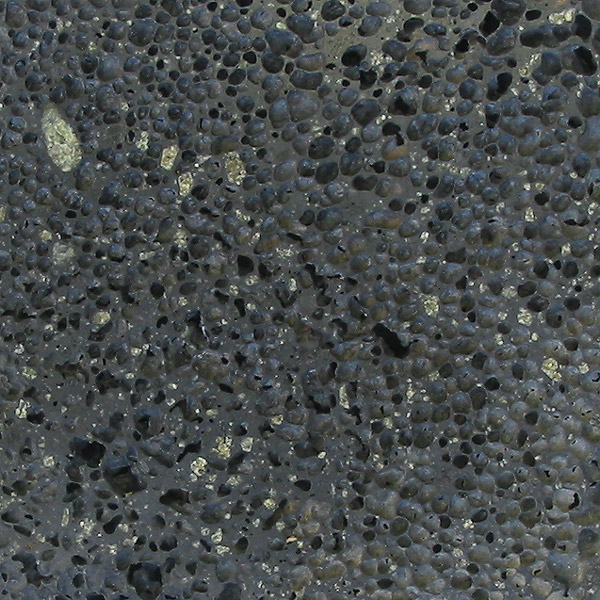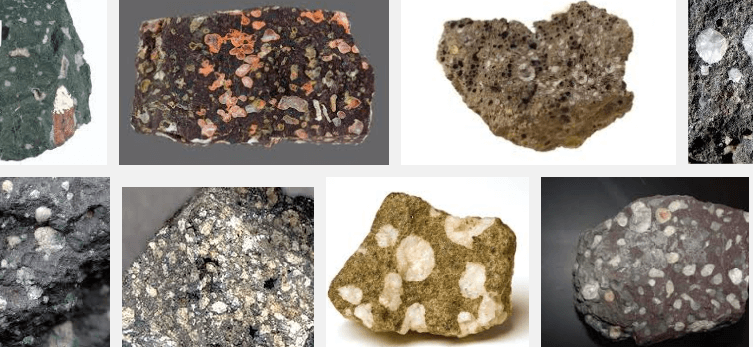Table of Contents
We can list volcanic rocks that are formed at or near the surface by comparatively quick cooling of lava, cannot be classified without the aid of the microscope and chemical analysis, except roughly as light-colored and dark lavas, conveniently called rhyolite, and basalt or trap.
Rhyolite
Rhyolite is made of light-colored acid lava flows, often called felsite, particularly when it has a somewhat granular appearance. Rhyolite sometimes occurs as dikes. Color, white or gray, sometimes red, yellow, brown, or green; G = 2.4 to 2.7; fine-grained, with “flow” structure. The fresh broken surface of rhyolite shows thin flakes, which are light-colored even when the rhyolite is comparatively dark. The same appearance is seen at thin edges of a broken piece. The break of rhyolite is apt to be smooth, with curved surfaces like a shell (conchoidal). But in other cases, especially surface flows, the break may be hackly with a rough feel. When near ore deposits of the vein kind, rhyolite is often changed to a soft mass, which may be clay or sericite. The weathered surface is dull gray, brownish, or reddish. Rhyolite contains 70% to 80% of silica.
As a field name, rhyolite includes rhyolite proper having the composition of granite, trachyte having the composition of syenite, and phonolite with composition of nepheline-syenite.
Visible crystals (phenocrysts) of feldspar are sometimes present, and there are occasionally visible quartz, biotite, pyroxene, and hornblende crystals. The quartz crystals often show as small, round, glassy spots, “bird’s eyes.” Small vugs filled with crystals of quartz, etc., are sometimes seen. Some specimens of rhyolite are rather dark and might be mistaken for basalt, but thin slivers are translucent and look white, which is not the case with basalt.
Obsidian
Obsidian is glassy in texture, from quick cooling. It has conchoidal fracture. Color, jet black to red.
Pitchstone
Pitchstone is a dark green or nearly black rock of dull, pitchy luster and conchoidal fracture.
Pumice
Pumice is acid lava of a fine vesicular structure;that is, full of very small cavities or vesicles which have been formed by the stream in the lava.
Basalt or Trap
Basalt is formed from dark-colored, basic lava-flows, sometimes as dikes. Color, gray-black to black, usually not white in thin flakes as rhyolite is; heavy, G = 2.9 to 3.1; silica, 40% to 55%, Phenocrysts (visible crystals) of pyroxene feldspar, and olivine sometimes show. Sometimes basalt is plainly crystalline; but parts that have cooled rapidly from contact with cold rocks are glassy, as in basalt dikes next to the walls.
Basalt is much jointed, often in a very regular way as in the Giant’s Causeway, Ireland, and at places in British Columbia. The weathered surface is usually rusty, sometimes green. The vesicular structure (roundish holes) is common, and the hollows are sometimes about the shape of almonds, from which the name, amygdaloid basalt when these hollows are filled with calcite, quartz, etc., as secondary minerals. The surface of basalt may be weathered green by the formation of chlorite, or rusty brown or red from oxides of iron. Serpentine, carbonates, red oxide of iron, and clay are apt to be formed near ore deposits in basalt. Basalt (trap) is one of the best materials for roads and concrete. Basalt, if well crystallized, would form gabbro or diabase. The name trap is often used for fine-grained diabase as well as for basalt.
Andesite
Andesite is a dark, fine-grained volcanic rock of the composition of diorite.
